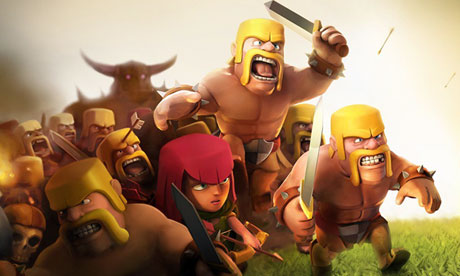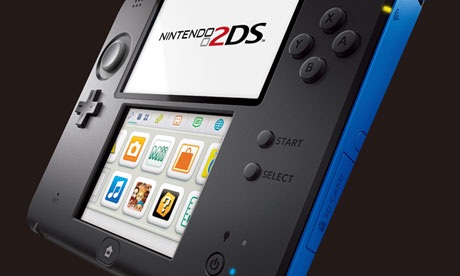- Joined
- Sep 19, 2013
- Messages
- 291
- Points
- 0
Mobile gaming's rise is a headache for Sony and Nintendo
The iPhone 5s is Apple's most powerful gaming device yet, and games revenues on iOS and Android are soaring. How will 3DS and PS Vita respond?
Stuart Dredge
The Guardian, Wednesday 25 September 2013 10.51 BST

Infinity Blade III is one of the mobile games taking the handheld battle to Sony and Nintendo
Nintendo's Game Boy, DS and 3DS devices gave it a long run as the king of handheld gaming. In 2013, though, its crown is slipping in the face of competition from games on smartphones and tablets.
A recent report from research firms IDC and App Annie estimates that games for devices running Apple's iOS and Google's Android software are making four times the revenues of games for Nintendo and Sony's handheld devices combined.
Mobile gaming is booming. Research firm comScore estimates that 20m people in the UK play mobile games every month, while 6.2m play them every day. Another analyst, IHS Screen Digest, expects Brits to spend nearly £300m on mobile games this year.
Some of the largest traditional games publishers are capitalising on this growth. In its last financial quarter, Electronic Arts – owner of franchises including The Sims and FIFA – made £7.7m from games on Sony handhelds, and £5.8m from those on Nintendo devices. In the same quarter, EA's mobile games revenues were $113m (£72.6m).
"Apple was EA's biggest retail partner measured by sales," said chief operating officer Peter Moore in the company's earnings call with analysts in July. "That is a first."
The current strength of mobile gaming is about more than big publishers like EA. The market is being driven as much by independent developers who, if they strike it lucky on Apple and Google's app stores, can rapidly overtake even the largest rivals.
Finnish developer Supercell, for example, made £114.8m of revenues in the first quarter of 2013 from just two games on iOS: Hay Day and Clash of Clans. A subsequent £83.4m funding round valued the company at nearly £500m.
"Our growth speaks a lot about the platform that we're on, and how quickly games can spread organically," Ilkka Paananen, Supercell's chief executive, told The Guardian recently.
Another developer, Japanese firm GungHo Online, reported £286m of revenues in the second quarter of this year, with the majority of its sales coming from a single mobile game, Puzzle & Dragons. The publicly-listed company's market cap overtook Nintendo's in May.
"This is a market which is new, and which is at the beginning of its creative journey, not the end. But it's already winning," says Nicholas Lovell, of games industry consultancy Gamesbrief.
"What's more, it's making so much more money than the other platforms, creativity will be drawn towards mobile. You don't have to know the right people in order to get through the door: anyone can experiment, and publish their game."

Clash of Clans helped mobile developer Supercell make £114.8m in the first quarter of 2013
UK games industry body TIGA surveyed developers in April 2013, and found that 37% of British games studios were primarily focused on mobile, up from 19% in 2010. For studios founded in 2011 and 2012, the percentage rose to 53%.
"It's not a brain drain away from the [traditional] industry. I'd argue that if these developers weren't making mobile games, they wouldn't be making games full stop. It's more of an expansion of the market," says Dr Richard Wilson, TIGA's chief executive.
"Whilst yes, there is a threat to Sony's and Nintendo's handheld business, the rise of mobile – Android and iOS games – can also be seen as a new opportunity for new developers, something that overall makes the market bigger."
Mobile gaming has its controversies, particularly around the dominance of "free-to-play" games that are free to download and play, but which charge for virtual items and currency using in-app purchases.
Critics often claim that this business model encourages developers to think less about the art of gameplay than the science of monetisation, with gameplay geared towards pushing players to spend money as often as possible.
"Clearly there are practices in free-to-play games now that are unsustainable and don't do the industry any favours, but there is a new wave of companies coming who are focused on creating truly amazing entertainment." said Kristian Segerstrale, former executive vice president of digital games at EA who now sits on Supercell's board, in a recent Guardian interview.
Paananen agreed. "Games are still a form of art, not a form of science. You can't design fun on a spreadsheet. And if you want to make an industry for the long-term, if you can't create fun games, there's no future."
Others worry about the gold-rush mentality to the hundreds of new development studios setting their sights on being the next Supercell or GungHo.
"I do worry for a lot of mobile developers: you wonder how they're making anything back from it at all," says Miles Jacobsen, studio director at Sports Interactive, whose last Football Manager Handheld game sold more than 500,000 copies on iOS alone.
"There are now so many studios starting up on a weekly basis thinking they're going to be instantly successful. But less than 1% of games do well enough for you to make a career out of it on the platform, and if you're going free-to-play, the odds are even smaller."
Sony in particular is trying to win more of these developers back to its PS Vita and upcoming PlayStation 4 console. The company devoted a significant section of its press conference at August's Gamescom trade show to its plans to bring more indie studios to the PlayStation platform.
Since then, Sony has unveiled a new lighter version of the Vita handheld – PS Vita 2000 – aimed at casual users, which will go on sale in Japan on 10 October. It is also using the guts of Vita for a new microconsole, PlayStation Vita TV, which will play handheld games on a TV screen.
Nintendo, meanwhile, is taking the 3D out of its 3DS with the upcoming launch of its 2DS handheld on 12 October. It ditches the 3D screen, is cheaper at £110, and is a flat, open-faced gadget rather than a clamshell device. Neither company is calling it quits just yet, then.
"Developers just want to be able to create great games, and see a fair return for doing so. If Sony and Nintendo can offer them a device, toolset and a marketplace with which to do that, then yes, absolutely they can increase the number of developers making games for their platforms," says Wilson.

Nintendo 2DS ditches the 3D screen and clamshell design
While Nintendo has stuck to its policy of only releasing games for its own devices, Sony – which makes its own range of smartphones and tablets – has extended the PlayStation brand to these and other Android devices.
It also partnered with Coca-Cola to launch an iOS and Android app – PlayStation All-Stars Island – with mini-games based on franchises including Uncharted and LittleBigPlanet. The third console giant, Microsoft, has rolled its Xbox brand onto its Windows Phone smartphones and Windows 8 tablets.
Joining the mobile games revolution is a viable option, rather than trying to beat it. The competition from mobile games can be constructively disruptive for the traditional industry, rather than merely destructive.
And for developers? Excitement about the creative potential of smartphones and tablets alongside traditional handhelds is common, but the new business models involved elicit enthusiasm and fear in equal measure.
"There has never been more scope for creativity in handheld gaming," says Dr Jo Twist, chief executive of industry body UKIE. "We've already seen how iOS and Android platforms have also opened up games to a whole new audience, who never previously saw themselves as gamers, and this can again only benefit the wider industry."
The market is fluid, too. New devices are emerging to blur the boundaries between mobile and handheld gaming even more. Nvidia's Shield, for example, is an Android-powered handheld selling for $299 in the US and Canada, with features including the ability to stream PC games.
"We've seen a lot of developers shift their focus from traditional console platforms to mobile platforms and/or free to play. AAA console games cost tens of millions of dollars to develop, and most developers don't have the resources to compete," says Nvidia's vice president of game content and technology Ashutosh Rege.
"Mobile platforms and free to play on PC enable more developers to compete. In the long run, we believe that open-platforms like the PC and Android will attract more developers. When virtually every kid has a mobile device and every adult has a PC, developers will target those audiences."
Meanwhile, Apple's new iPhone 5s is the company's most powerful gaming device yet, with the company touting its 64-bit A7 processor as a key driver for the next generation of mobile games – Infinity Blade III was held up as the first example at the handset's launch event.
That, plus Apple's new specs for "MFi" controller accessories for iOS devices, and its existing AirPlay technology and Apple TV set-top box, suggests the debate will soon move beyond whether smartphones and tablets are challenging dedicated gaming handhelds.
In five years' time – and quite possibly sooner – these devices could be legitimate challengers to PlayStation 4 and Xbox One in the living room. In 2013, there's a huge gulf between Grand Theft Auto V on console and the decade-old Grand Theft Auto: Vice City that iOS and Android devices can run.
But by the time GTA VI rolls into town, the barricades between mobile and console gaming – let alone mobile and handhelds – may be falling down.
